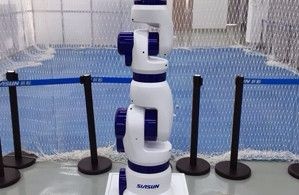China Wants to Replace Millions of Workers with Robots.China is planning so as to lay the basis for a robot transformation to computerize the work right now done by a huge number of low-paid specialists.
The administration’s arrangement will be urgent to a more extensive push to change China’s economy while likewise meeting the aspiring generation objectives laid out in its most recent monetary plan, which expects to twofold for each capita wage by 2020 from 2016 levels with no less than 6.5 percent yearly development. The accomplishment of this exertion could, thus, influence the essentialness of the worldwide economy.
The scale and significance of China’s robot aspirations were clarified when the VP of the People’s Republic of China, Li Yuanchao, showed up at the nation’s first real mechanical technology gathering, held as of late in Beijing. Standing in front of an audience between two humanoid amusement robots with outsized heads, Li conveyed a message from China’s pioneer, Xi Jinping, complimenting the coordinators of the exertion. He additionally made it clear that apply autonomy would be a noteworthy need for the nation’s monetary future.
A considerable lot of the robots on show at the gathering’s presentation lobby were administration or amusement robots, for example, robotized vacuum cleaners, shoddy automatons, or eccentric looking machines intended to serve as individual partners. In any case, there were additionally numerous mechanical robots that flagged the genuine driving force for China’s robot push: its assembling part.
China is as of now the world’s biggest maker of everything from garments to hardware, yet a lot of it relies on upon minimal effort, low-expertise work. Also, even as monetary development has moderated, wages keep on ascending the nation over as the economy advances. The Chinese government is additionally willing to see its workforce enhance and its assembling commercial enterprises turn out to be all the more innovatively progressed.
The most recent robot from China’s Siasun has six joints, making it more dextrous.
Robots may offer a shrewd answer for some of these difficulties. In the event that more robots can be conveyed effectively in numerous assembling plants, this would expand effectiveness while likewise permitting a few laborers to be supplanted. In the meantime, on the grounds that more skilled robots will require propelled detecting, control, and knowledge, the drive could advance the specialized ability of the remaining assembling laborers, and also those utilized in outlining, building, and adjusting these assembling machines.
The size of this robot upheaval could be gigantic. Two years back China turned into the world’s biggest merchant of robots, and the International Federation of Robotics, an industry gathering, gauges that China will represent more than 33% of every single modern robot introduced worldwide by 2018. Yet the quantity of robots per laborer in China is far lower than in numerous modernly propelled nations, demonstrating an enormous potential for development.
A more far reaching push to update China’s assembling base is as of now in progress, under a project reported in May known as Made in China 2025, which intends to make China an imaginative and green “world assembling force” by that year. The exertion includes adding network and insight to assembling hardware and plants, to enhance general adaptability and effectiveness. It was propelled by Germany’s Industry 4.0 exertion, dispatched in 2011, and by comparable endeavors to advance more propelled assembling in the U.S.
The mechanical segment of this upgrade will be about more than simply introducing more robots in assembling plants, on the other hand. A portion of the assignments presently done by people can’t without much of a stretch be computerized easily while others, for example, fine control or visual investigation, will require modern equipment and programming to automate.
Tianran Wang, an individual from the Chinese Academy of Engineering and a specialist on modern robotization, talked about China’s assembling industry at the Beijing occasion. He said that it falled behind those of different countries and would require a noteworthy mechanical redesign. He likewise accentuated that some portion of the test will be making sense of which errands can be computerized most successfully, and how machines and people can share the workload. “Not all work serious industry can be mechanized,” Tianran said. “We require cross breed mechanization.”
China might soon get to be not just an imperative business sector for more progressed mechanical innovation, however a maker of more propelled robot frameworks itself. Numerous universal robot creators were available at the Beijing gathering, including the German titan Kuka and the Swiss organization ABB. In any case, many Chinese robot organizations were additionally present, including some organizations that have just been around for a couple of years.
Siasun, a mechanical robot producer situated in Shanghai, is building up a scope of robots intended to offer manufacturing plants some assistance with automating a greater amount of their work. In a modern park on the edges of the city, at a showroom where the organization exhibits new items to forthcoming clients.
I saw a skillful new six-pivot robot arm in real life and additionally wheeled robots that move items from one piece of a generation line to the following. The organization is additionally creating automated arrangements that are altered for particular commercial ventures, for example, a robot for climbing so as to paint the sides of boats here and there a link that hangs down the side of the body.
Daokui Qu, the president of Siansun, said the needs for robot creators would be to grow more adaptable frameworks with cutting edge detecting, and in addition discovering better routes for robots to drudge viably and securely close by human specialists. He included that the organization had effectively gotten a considerable measure of requests for the portable robot arm it was creating, and that it was building up a motion controlled robot that ought to be less demanding for specialists to collaborate with.

Before leaving the stage to visit the Beijing meeting’s show lobby, Vice President Li proposed that mechanical autonomy specialists and organizations from outside the nation would be welcome to tune in the nation’s robot transformation: “China might want to welcome robot specialists and business people from everywhere throughout the world to speak and coӧperate with us, keeping in mind the end goal to push forward the improvement of robot innovation and industry.



